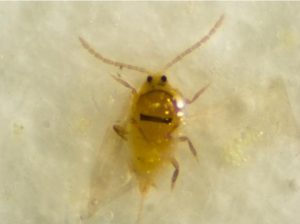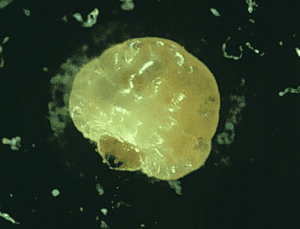Developing an IPM Plan for San Jose Scale
Author: Evan Lentz
Evan.Lentz@uconn.edu
Reviewers: Mary Concklin and Shuresh Ghimire, UConn Extension
Publication EXT111 | March 2025
Introduction
The San Jose Scale (SJS) compromises fruit quality and, in instances where they are allowed to establish, pose a significant risk to production. This fact
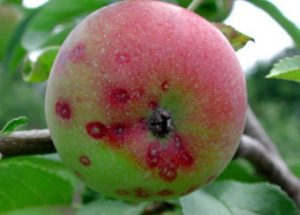
sheet highlights the components of a year-long IPM plan for managing San Jose Scale populations, and provides relevant background and resources.
San Jose Scale (Quadraspidiotus pernicious) is a small scale insect introduced to the United States from China in the early 1870s. Since its introduction, it has spread to most of the U.S., and continues to pose key challenges to the fruit industry. The high reproductive capacity, multiple generations, and small size make them difficult to manage, especially in older orchards with complex architecture that inhibit adequate spray penetration, or in locations where populations are allowed to establish unchecked.
The best method for managing this pest is preventing populations from getting established in the first place.
Hosts
Although most troublesome for apple and pear producers, SJS can also infest sweet cherry, peach, prune, berry bushes, nut trees and some ornamentals.
Description & Life Cycle
In the Northeast region of the United States, San Jose Scale usually has two generations per year. SJS overwinters in the immature blackcap stage on the
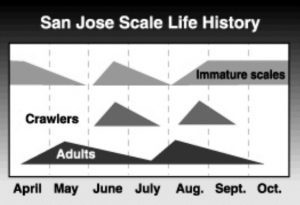
surfaces of trees, and mature to adults during bloom (Figure 2). Males emerge shortly after, during petal fall, to mate. SJS females begin to give birth to live
young, or crawlers, over a six-week period, beginning in early June and continuing until August. Females are prolific and can give birth to up to 400 live young at a time. The first generation will mature by late July with the second generation of crawlers being produced from late July to early September.
Generations often overlap and crawlers can spread easily from tree to tree via wind, wildlife, and human activity. Immature SJS progresses through three stages: crawlers, white cap, and the overwintering black cap stage.
Identification
Adult males are yellowish tan with a dark band across the back, have wings, and long antennae (Figure 3). Adult females are yellow, wingless, legless, and have a soft globular shaped body about the size of a pin head with a central nipple-like bulge (Figure 4).
Crawlers are lemon-yellow color, have six legs, two antennae, a long beak for feeding, and resemble spider mites (Figure 5). Crawlers develop into the white
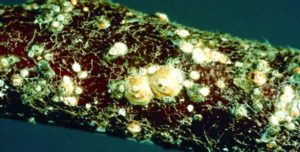
cap stage, secreting a white waxy covering that will mature to a gray-black color.
Scales are either disk-shaped (females) or oval (males) and are composed of concentric rings of their waxy coating (Figure 6). Depending on the time ofyear, scales may be a white, gray, or black-brown color.
Damage
The primary damage from SJS is the result of feeding, which causes a dark purplish/red coloration around the feeding site. These feeding sites often develop

a slight depression or sunken appearance. Over time, the feeding sites will grow in size and fade to a lighter red or pink color–making them more difficult to see on red-skinned varieties (Figure 7).
Secondarily, trees with larger infestation of SJS may experience other challenges related to the loss of sap through insect feeding. These include the production of smaller, immature fruit such as apples, death of shoots and limbs, cracking or splitting of wood, reduced vigor, reduced yields, and even tree death.
Monitoring
Pheromone traps can be used to monitor adult male SJS emergence starting at the pink stage. Traps should be placed in areas with established populations
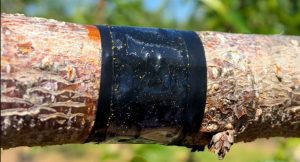
or potential infestations, and checked weekly. Crawler emergence can also be monitored starting in June. Black electrical tape should be wrapped, sticky side out, on both sides of scale infestation found on branches. A thin layer of petroleum jelly can be spread on the tape. Once crawlers emerge, they will
travel across the tape and get caught in the jelly.
Although tiny, the yellow SJS crawlers will be visible against the black background of the tape (Figure 5). Scouting for overwintering scale populations on trees can be done during regular off-season activities such as pruning. The NEWA San Jose Scale forecasting model can be used in conjunction with other monitoring efforts to properly time spray applications.
Management
Cultural – Pruning out infested branches is an effective means of reducing overwinter populations. Additionally, regular pruning serves to improve the penetration of sprays applied later in the year.
Chemical – The first chance for chemical control is a dormant or delayed dormant oil application. These oils work to deprive overwintering scales of oxygen, and will help to reduce the overwintering population.
If monitoring traps confirm the presence of males and populations are high, an insecticide can be applied at early petal fall to control males SJS before they mate with females. In June, once crawler emergence has been confirmed with monitoring traps, insecticides targeting crawlers can be applied.
It is recommended that two sprays be applied: one at first emergence and one at peak emergence, 7-10 days later. For specific recommendations on materials and rates, please consult the New England Tree Fruit Management Guide. Insecticides need to be rotated.
Biological – There are several species of parasitoid wasps (Aphytis and Encarsia) that can help to curb populations. However, biological control is insufficient on its own and broad-spectrum insecticides used in the orchard will impact natural biological control.
Developing an IPM Plan for San Jose Scale
- Scouting during dormant pruning activities can help to locate infested branches and trees. Heavily infested branches can be pruned off and disposed of. If established populations exist, pruning efforts should be directed at opening the canopy to improve spray penetration. Sprayer calibration should be done prior to the start of the season.
- A dormant or delayed dormant oil application can be applied before pink bud stage to reduce overwintering populations.
- Pheromone traps should be placed in areas of concern starting at the pink stage. If initial populations of males are high, an insecticide can be applied at early petal fall to reduce mating.
- The Network for Environment and Weather Applications (NEWA) model should be utilized at this point. Enter location and first adult capture dates into the model for recommendations.
- Starting in June, place black electrical tape around infested branches to monitor for crawler emergence.
- Once crawlers emerge, two sprays should be applied: one at first emergence and another 7-10 days later at peak emergence. Materials must be rotated.
- The NEWA site will assist in determining the timing of the second generation. Second generation crawlers should be monitored in the same way that the first was, utilizing black electrical tape traps.
- Once the second generation emerges, two sprays should be applied: one at first emergence and another 7-10 days later at peak emergence. Materials must be rotated.
- Note should be made of the locations with SJS infestations and if there are varieties that SJS seem to prefer over others. This information can be used to inform your IPM plan in subsequent years.
- Over time, an adequate IPM plan will help to reduce established populations and prevent new ones from establishing. Once populations have been reduced, adjusting the IPM plan is recommended, as it might not be necessary to employ all the above tactics each year.
Resources
WSU Extension – https://treefruit.wsu.edu/crop-protection/opm/san-jose-scale/
MSU Extension – https://www.canr.msu.edu/ipm/diseases/san_jose_scale
New England Tree Fruit Management Guide – https://netreefruit.org/homepage
NEWA San Jose Scale Forecasting Model – https://newa.cornell.edu/san-jose-scale
The information in this document is for educational purposes only. The recommendations contained are based on the best available knowledge at the time of publication. Any reference to commercial products, trade or brand names is for information only, and no endorsement or approval is intended. UConn Extension does not guarantee or warrant the standard of any product referenced or imply approval of the product to the exclusion of others which also may be available. The University of Connecticut, UConn Extension, College of Agriculture, Health and Natural Resources is an equal opportunity program provider and employer.
